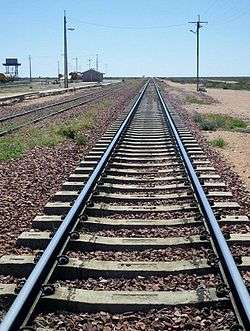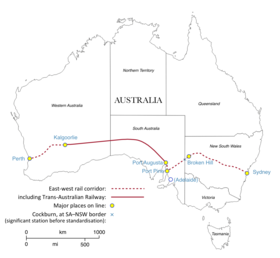Trans-Australian Railway
The Trans-Australian Railway, opened in 1917, crosses the Nullarbor Plain of Australia from Port Augusta in South Australia to Kalgoorlie in Western Australia. As the only rail freight corridor between Western Australia and the eastern states, the line is strategically important.
| Trans-Australian Railway | ||||||||||||||||||||||||||||||||||||||||||||||||||||||||||||||||||||||||||||||||||||||||||||||||||||||||||||||||||||||||||||||||||||||||||||||||||||||||||||||||||||||||||||||||||||||||||||||||||||||||||||||||||||||||||||||||||||||||||||||||||||||||
|---|---|---|---|---|---|---|---|---|---|---|---|---|---|---|---|---|---|---|---|---|---|---|---|---|---|---|---|---|---|---|---|---|---|---|---|---|---|---|---|---|---|---|---|---|---|---|---|---|---|---|---|---|---|---|---|---|---|---|---|---|---|---|---|---|---|---|---|---|---|---|---|---|---|---|---|---|---|---|---|---|---|---|---|---|---|---|---|---|---|---|---|---|---|---|---|---|---|---|---|---|---|---|---|---|---|---|---|---|---|---|---|---|---|---|---|---|---|---|---|---|---|---|---|---|---|---|---|---|---|---|---|---|---|---|---|---|---|---|---|---|---|---|---|---|---|---|---|---|---|---|---|---|---|---|---|---|---|---|---|---|---|---|---|---|---|---|---|---|---|---|---|---|---|---|---|---|---|---|---|---|---|---|---|---|---|---|---|---|---|---|---|---|---|---|---|---|---|---|---|---|---|---|---|---|---|---|---|---|---|---|---|---|---|---|---|---|---|---|---|---|---|---|---|---|---|---|---|---|---|---|---|---|---|---|---|---|---|---|---|---|---|---|---|---|---|---|---|---|
| ||||||||||||||||||||||||||||||||||||||||||||||||||||||||||||||||||||||||||||||||||||||||||||||||||||||||||||||||||||||||||||||||||||||||||||||||||||||||||||||||||||||||||||||||||||||||||||||||||||||||||||||||||||||||||||||||||||||||||||||||||||||||
| ||||||||||||||||||||||||||||||||||||||||||||||||||||||||||||||||||||||||||||||||||||||||||||||||||||||||||||||||||||||||||||||||||||||||||||||||||||||||||||||||||||||||||||||||||||||||||||||||||||||||||||||||||||||||||||||||||||||||||||||||||||||||
It includes the world's longest section of completely straight track. The inaugural passenger train service was known as the Great Western Express; later it became the Trans-Australian. As of 2020, two passenger services use the line: the Indian Pacific for its entire length, and The Ghan between Port Augusta and Tarcoola before it proceeds north to Darwin.
History

In 1901, the six Australian colonies federated to form the Commonwealth of Australia. At that time, Perth, the capital of Western Australia, was isolated from the remaining Australian States by thousands of miles of desert terrain and the only practicable method of transport was by sea, a time-consuming, inconvenient and often uncomfortable voyage across the Great Australian Bight, a stretch of water known for rough seas. One of the inducements held out to Western Australians to join the new federation was the promise of a federally funded railway line linking Western Australia with the rest of the continent.
In 1907 legislation was passed, allowing for the route to be surveyed. The survey, completed in 1909, endorsed a route from Port Augusta (the existing railhead at the head of Spencer Gulf in South Australia's wheatfields) via Tarcoola to the gold mining centre of Kalgoorlie in Western Australia, a distance of 1,063 miles (1,711 km). The line was to be to the standard gauge of 4 ft 8 1⁄2 in (1,435 mm), even though the state railway systems at both ends were narrow gauge at the time. Its cost was estimated at £4,045,000.
Legislation authorising the construction was passed in December 1911 by the Fisher Commonwealth Government and work commenced in September 1912 in Port Augusta.
Work proceeded eastwards from Kalgoorlie and westwards from Port Augusta through the years of the First World War. By 1915, the two ends of the line were just over 600 miles (966 km) apart with materials being delivered daily.[1] Construction progressed steadily as the line was extended through dry and desolate regions until the two halves of the line met at Ooldea on 17 October 1917.[2][3]
Commonwealth Railways was established in 1917 to administer the line.
In 1937 the eastern end was extended south to Port Pirie, reducing one break of gauge in the journey across Australia, but at the same time establishing a three-gauge junction at Port Pirie, with the South Australian Railways line to Adelaide being 1,600 mm (5 ft 3 in) broad gauge.
The long-anticipated conversion of the entire line between Sydney and Perth to standard gauge occurred in 1970.
In 2004, the gap in standard gauge connections between the mainland state capitals was finally closed with a connection between Port Pirie and Adelaide, thence Melbourne, and by completion of the Adelaide–Darwin railway, which diverges from the Trans–Australian Railway at Tarcoola.
In 2008, the engineering heritage of the railway was recognised by the Engineering Heritage Recognition Program of Engineers Australia when markers were installed on the platform at the Port Augusta station in South Australia and the ticket office at Kalgoorlie station in Western Australia.[4]
On 17 October 2017, centenary celebrations were held at Ooldea.[5]
Named services
When the line was inaugurated, the passenger service was named as the Great Western Express.[6] Later, the train became known as the Trans-Australian or, colloquially, "The Trans". After the Sydney–Perth route was converted to standard gauge in 1970, the railway was no longer flanked at both ends by narrow-gauge lines and an all-through service, called the Indian Pacific, was started. Although passengers no longer had to move to different carriages at change-of-gauge localities, Commonwealth Railways remained responsible for the service where it operated between Port Pirie and Kalgoorlie, with its crews and locomotives taking over at those stations. In 1975, Commonwealth Railways was absorbed into an enlarged federal government corporation, Australian National Railways Commission, branded as Australian National Railways and later as "AN", which continued to operate the Trans Australian.[7] In 1993, Australian National took over operation of the entire coast-to-coast service following agreement with the governments of Western Australia and New South Wales.[8]
In 1997 the Indian Pacific was sold to a company, Great Southern Rail (as of 2020 trading as "Journey Beyond"), following the privatisation of Australian National.[9] As of 2020, the Indian Pacific is an all-through weekly service.[10]
From the start of construction until 1996, the Tea and Sugar supply train carried vital provisions to the work sites and localities, all of them isolated, along the route: a butcher and banking and postal services were among the services on board.
Terrain
The line's distance as constructed was 1,051.73 mi (1,692.60 km), slightly less than the original survey.
The railway includes the longest stretch of straight track in the world. A Commonwealth Railways map marks the western end as 793 miles from Port Augusta, between Loongana and Nurina, and states: "The 'Long Straight' extends from this point for a distance of 297 miles and terminates at the 496 miles [sic] between Ooldea and Watson."[note 1]
According to former astronaut Andy Thomas, the line is identifiable from space because of its unnatural straightness: "It's a very fine line, it's like someone has drawn a very fine pencil line across the desert".[13]
At no point along the route does the line cross a permanent fresh watercourse. Bores and reservoirs were established at intervals, but the water was often brackish and unsuitable for steam locomotive use, let alone human consumption, so water supplies had to be carried on the train. In the days of steam locomotion, about half the total load was water for the engine. In later years, condenser plants were built at several major stations.
Names of stopping places

Reflecting the line's ownership by the Commonwealth Government, eight of the localities were named (or renamed) after Australian Prime Ministers. Other prominent people's names were also allocated, as shown on the adjacent map.
Operations
.jpg)
Because of the inevitable problems of finding suitable water for steam locomotives in a desert, the original engineer, Henry Deane envisaged diesel locomotives for the line and made inquiries with potential manufacturers, although the technology was not well developed at the time. Unfortunately, a scandal involving the supply of sleepers led to Deane's resignation before the proposal had advanced.[14]
Initially trains were hauled by G class locomotives and from 1938 by C class locomotives, both steam.[15] From 1951, diesel-electric locomotives hauled passenger services, using the new GM class locomotives.[16]
The railway originally had 400 m (1,300 ft)-long crossing loops (passing sidings) every 100 km (62 mi) or so. As traffic increased the number of crossing loops increased. To handle longer trains, crossing loops were lengthened so that in 2008 they were all at least 1,800 m (5,900 ft) long and spaced about 30 km (19 mi) to 60 km (37 mi) apart.
Most crossing loops are unattended and train crew operate the turnouts as required. Crossing loops have self-restoring points, so that points are reset to the straight route when a train departs from a crossing loop. The loops are fitted with radio controls so that train crew can set the points as they approach. Locomotive cabs are fitted with an activated points system (ICAPS) to set the required route without having to stop the train.[17]
Safeworking is by train orders, using verbal communication.[17]
Notes
- The metric equivalents to the mileages on the map are: western end 1276.2 km from Port Augusta, eastern end 798.2 km from Port Augusta; length 478.0 km. Details measured via Google Earth are: western end 30°58′33″S 126°40′08″E, eastern end 30°28′10″S 131°37′41″E[11] – a distance of 478.24 km.[12]
References
- "The Federal line". The West Australian. Perth: National Library of Australia. 16 April 1915. p. 6. Retrieved 16 October 2013.
- Chambers, T.F. (1968) The Golden Jubilee of the Trans Australian Railway Australian Railway Historical Society Bulletin November, 1968 pp267-275
- "The Last Link". The West Australian. XXXIII (4, 850). Western Australia. 18 October 1917. p. 4. Retrieved 17 October 2017 – via National Library of Australia.
- "Trans-Australian Railway, 1917". Engineering Heritage Recognition Program. Engineers Australia. Archived from the original on 30 June 2016. Retrieved 19 June 2016.
- Taylor, Paige (17 October 2017). "Celebrating rail's united nation, 100 years on". The Australian.

subscription: the source is only accessible via a paid subscription ("paywall") - "Linking the Capitals - The East-West line". Observer. Adelaide, SA. 24 November 1917. p. 24. Retrieved 24 November 2015.
- "Interstate cutbacks" Railway Digest July 1991 page 231
- "IP to come under sole control of AN" Railway Digest March 1992
- Great Southern Railway Consortium completes acquisition of Australian National Railways Passenger Business Archived 10 April 2011 at the Wayback Machine Serco Group plc 31 October 1997
- Indian Pacific Timetables 2016-2017 Great Southern Rail
- Google Earth (searches for "Ooldea, Cook SA" and "Loongana, Forrest WA")
- Williams, Ed (2020). "Great Circle Calculator". edwilliams.org. Retrieved 12 May 2020.
- Debelle, Penelope (10 October 2014). "Adelaide's own spaceman Andy Thomas". The Advertiser. Adelaide. Retrieved 19 October 2014.
- Burke, David (1991). Road through the wilderness: the story of the Transcontinental Railway, the first great work of Australia's Federation. Kensington NSM: New South Wales University Press. ISBN 0868401404.
- Oberg, Leon (1984). Locomotives of Australia 1850's – 1980's. Frenchs Forest: Reed Books. pp. 122, 164. ISBN 0-730100-05-7.
- New Train Service Across Australia The West Australian 12 November 1951
- "Overrun of authority involving train 6MP5" (pdf). Canberra: Australian Transport Safety Bureau. 7 July 2014. Retrieved 3 May 2017.
Bibliography
- Adam-Smith, Patsy (1974) The Desert Railway. Adelaide: Rigby ISBN 0-85179-675-3
- Anchen, Nick (2017). Iron Roads in the Outback: The Legendary Commonwealth Railways. Ferntree Gully, Vic: Sierra Publishing. ISBN 9780992538828.
- Avery, Rod (2006). Freight Across the Nation: The Australian Superfreighter Experience. Brisbane: Copyright Publishing Co. ISBN 1876344474.
- Buckland, J.L. (1965) Canadian and American Locomotives in Wartime Service on the Trans-Australian Railway Australian Railway Historical Society Bulletin, September, 1965.
- Burke, David, (1991) Road Through the Wilderness: The Story of the Transcontinental Railway, the First Great Work of Australia's Federation. Kensington, N.S.W.: New South Wales University Press. ISBN 0-86840-140-4
- Cree, Patricia (2012). The Trans-Australian Railway: Bringing the nation together. Canberra Airport, ACT: Australasian Railway Association. ISBN 9780646584249.
- Henshaw, C.H. (1964) Overland to Perth in 1928 Australian Railway Historical Society Bulletin, April, 1964.
- Luke, Monte (1997). Riders of the Steel Highways: The History of Australia's Commonwealth Railways 1912-1975. Port Augusta, SA: VM & BM Luke. ISBN 0646346520.
- Spear, R. Clarke (1917) The Golden West: Trans-Australian Christmas number Perth, Western Australia "The Golden West, Vol. 13, December 1917."
See also
External links

- Centenary of the joining of the Trans Australian Railway Line - October 17, 2017
- Railpage detailed discussion and facts on the Trans Australia Railway
- Kalgoorlie to Port Augusta Railway Act 1911
- Kalgoorlie to Port Augusta Railway Survey Act 1907
- Australian Bureau of Statistics article on federal railways.
- Australia for Everyone: Railway Ghost Towns of the Nullarbor Plain – briefly describes each town and siding on the Trans-Australian Railway
- Port Augusta – Kalgoorlie rail map SA Track & Signal
